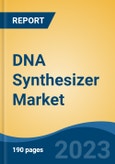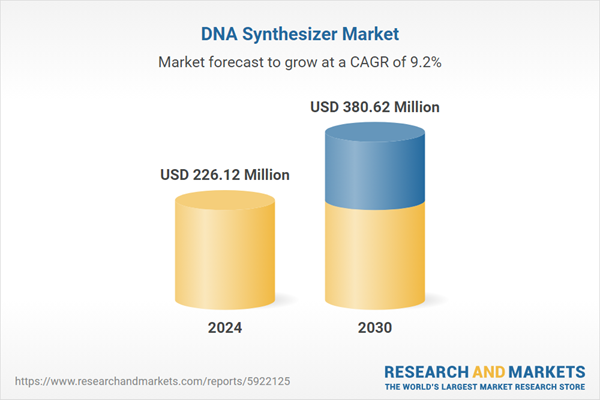Free Webex Call
The DNA Synthesizer Market was valued at USD 226.12 Million in 2024, and is expected to reach USD 380.62 Million by 2030, rising at a CAGR of 9.21%. The Global DNA Synthesizer Market has been witnessing significant growth driven by advancements in molecular biology, genetics, and the increasing demand for synthetic DNA in various applications. DNA synthesizers play a pivotal role in the field of biotechnology and life sciences by enabling the automated synthesis of nucleic acids, including DNA and RNA. Speak directly to the analyst to clarify any post sales queries you may have.
10% Free customizationThis report comes with 10% free customization, enabling you to add data that meets your specific business needs.
This technology is essential for applications such as gene synthesis, DNA sequencing, and molecular cloning. For instance, in May 2022, EVONETIX LTD announced the granting of a patent for its innovative thermally controlled DNA synthesis technology. This breakthrough allows for the precise synthesis of nucleic acids on a benchtop synthesizer platform, offering a more efficient and scalable solution for DNA production. The patented technology is expected to significantly advance the capabilities of genomic research and applications.
The rising focus on personalized medicine, genetic engineering, and synthetic biology has fueled the demand for DNA synthesizers. Researchers and biotechnologists utilize these instruments to create custom DNA sequences for diverse purposes, ranging from therapeutic development to agricultural improvements. The pharmaceutical and biotechnology industries are particularly prominent end-users of DNA synthesizers, leveraging the technology for drug discovery and development processes.
Key players in the global market are continually innovating to enhance the efficiency and capabilities of DNA synthesizers. Advancements in automation, throughput, and error correction technologies are contributing to the broader adoption of these instruments. The cost reduction strategies are making DNA synthesis more accessible to a wider range of research laboratories and companies. challenges in the market include ethical considerations surrounding the synthesis of DNA for potentially controversial applications and the need for standardized protocols to ensure the reproducibility and reliability of synthesized DNA. Regulatory frameworks are evolving to address these concerns and create guidelines for the responsible use of synthetic DNA.
Key Market Drivers
Advancements in Genetic Research
Advancements in genetic research stand as a primary catalyst for the unprecedented growth of the Global DNA Synthesizer Market. The ongoing quest to unravel the intricacies of the human genome and the genomes of various organisms has propelled the demand for cutting-edge tools, and DNA synthesizers have emerged as instrumental contributors to this scientific revolution.As researchers delve deeper into the genetic code, aiming to decipher the functions of genes and their role in health and disease, the need for precise and customizable DNA sequences has become paramount. For instance, in June 2022, Twist Bioscience unveiled its strategic plan to eliminate limitations in drug discovery using its advanced DNA synthesis platform. This innovation enhances the company’s ability to accelerate drug development, enabling more efficient creation of therapeutic candidates. The move significantly broadens Twist Bioscience’s capabilities in advancing the pharmaceutical industry.
DNA synthesizers, with their capability to automate the synthesis of nucleic acids, including DNA and RNA, play a pivotal role in facilitating the manipulation and study of specific genetic sequences. These synthesizers empower scientists to create custom DNA strands, accelerating the pace of genetic research by providing a tool for targeted investigations into gene functions and interactions. The synthesis of specific DNA sequences has become a cornerstone in genetic engineering, enabling the development of genetically modified organisms and innovative therapies.
Key Market Challenges
High Initial Costs
The Global DNA Synthesizer Market holds immense promise for advancing genetic research and biotechnological applications, a significant hurdle persists in the form of high initial costs. The capital-intensive nature of acquiring DNA synthesizers poses a challenge, particularly for smaller research laboratories and institutions aspiring to harness the power of synthetic DNA. This financial barrier inhibits the democratization of DNA synthesis technology, limiting access and hindering the widespread adoption of these critical instruments.The sophisticated technology and precision required in DNA synthesizers contribute to their substantial price tags. These instruments are equipped with advanced automation, error correction mechanisms, and high-throughput capabilities, all of which contribute to their efficacy in generating precise DNA sequences. However, these features also contribute to the overall cost, making DNA synthesizers a significant investment for research institutions, universities, and smaller biotech firms.
Key Market Trends
Growing Demand for Gene Editing Technologies
The Global DNA Synthesizer Market is experiencing a significant boost due to the growing demand for gene editing technologies, particularly the revolutionary CRISPR-Cas9 system. This trend is propelling DNA synthesizers into the forefront of genetic research and applications.Gene editing technologies, and CRISPR-Cas9 in particular, have revolutionized the field by providing researchers with unprecedented precision and efficiency in modifying DNA sequences. DNA synthesizers play a pivotal role in this process, allowing researchers to custom-create DNA sequences that serve as the templates for precise gene edits. The ability to synthesize specific DNA sequences with accuracy and speed is crucial for advancing gene therapy, functional genomics, and agricultural biotechnology. As the applications of gene editing technologies continue to expand across various industries, the demand for DNA synthesizers is on the rise.
Key Market Players
- Danaher Corporation
- Twist Bioscience Corporation
- Kilobaser
- LGC Limited
- CSBio Co
- K&A Labs GmbH
- DNA Script SAS
- OligoMaker ApS
- PolyGen GmbH
- Biolytic Lab Performance Inc
Report Scope:
In this report, the Global DNA Synthesizer Market has been segmented into the following categories, in addition to the industry trends which have also been detailed below:DNA Synthesizer Market, By Type:
- Benchtop DNA Synthesizers
- Large-scale DNA Synthesizers
DNA Synthesizer Market, By End use:
- Hospitals & Clinical Laboratories
- Academic & Research Institutes
- Pharmaceutical & Biotechnology Companies
DNA Synthesizer Market, By Application:
- Drug Discovery & Development
- Genetic Engineering
- Clinical Diagnostics
DNA Synthesizer Market, By Region:
- North America
- United States
- Canada
- Mexico
- Europe
- France
- United Kingdom
- Italy
- Germany
- Spain
- Asia-Pacific
- China
- India
- Japan
- Australia
- South Korea
- South America
- Brazil
- Argentina
- Colombia
- Middle East & Africa
- South Africa
- Saudi Arabia
- UAE
- Egypt
Competitive Landscape
Company Profiles: Detailed analysis of the major companies present in the Global DNA Synthesizer Market.Available Customizations:
With the given market data, the publisher offers customizations according to a company's specific needs. The following customization options are available for the report.Company Information
- Detailed analysis and profiling of additional market players (up to five).
This product will be delivered within 1-3 business days.
Table of Contents
1. Product Overview
2. Research Methodology
3. Executive Summary
4. Global DNA Synthesizer Market Outlook
5. Asia Pacific DNA Synthesizer Market Outlook
6. Europe DNA Synthesizer Market Outlook
7. North America DNA Synthesizer Market Outlook
8. South America DNA Synthesizer Market Outlook
9. Middle East and Africa DNA Synthesizer Market Outlook
10. Market Dynamics
11. Market Trends & Developments
13. Porter’s Five Forces Analysis
14. Competitive Landscape
Companies Mentioned
- Danaher Corporation
- Twist Bioscience Corporation
- Kilobaser
- LGC Limited
- CSBio Co
- K&A Labs GmbH
- DNA Script SAS
- OligoMaker ApS
- PolyGen GmbH
- Biolytic Lab Performance Inc
Table Information
| Report Attribute | Details |
|---|---|
| No. of Pages | 183 |
| Published | March 2025 |
| Forecast Period | 2024 - 2030 |
| Estimated Market Value ( USD | $ 226.12 Million |
| Forecasted Market Value ( USD | $ 380.62 Million |
| Compound Annual Growth Rate | 9.2% |
| Regions Covered | Global |
| No. of Companies Mentioned | 10 |









